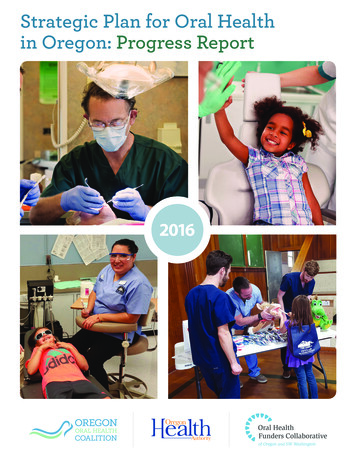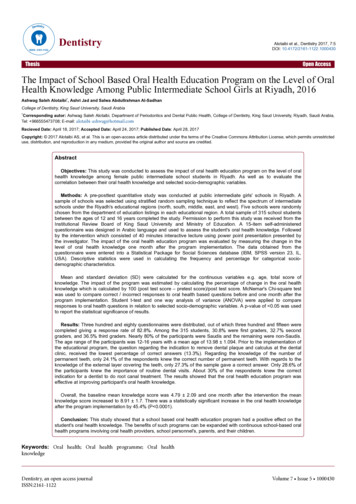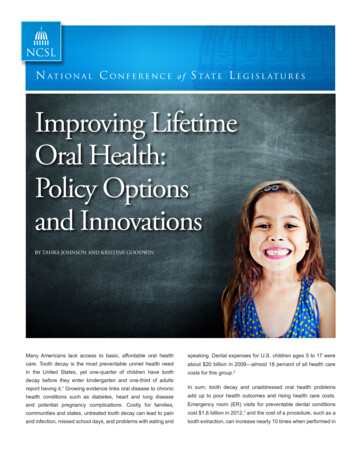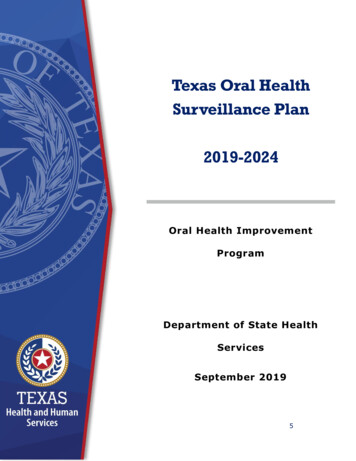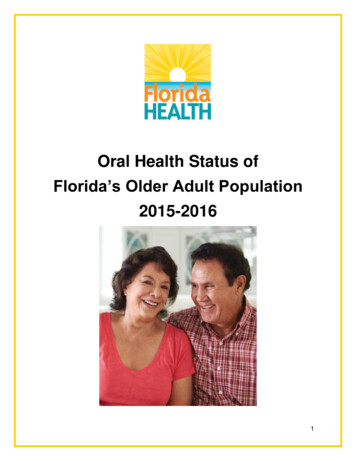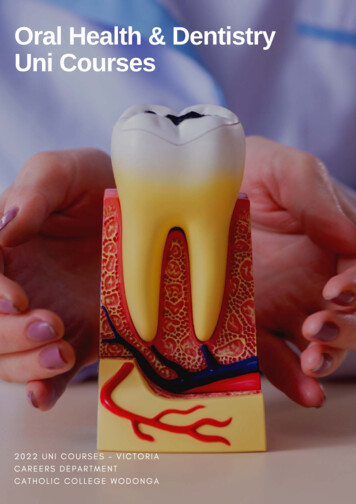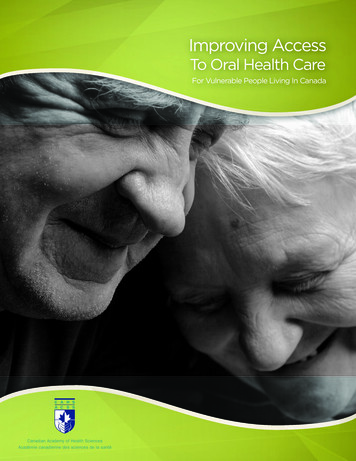
Transcription
Improving AccessTo Oral Health CareFor Vulnerable People Living In Canada
Improving Access To Oral Health CareFor Vulnerable People Living In Canada
The Canadian Academy of Health Sciences180 Elgin Street, Suite 1403, Ottawa, ON Canada K2P 2K3Notice: The project that is the subject of this report was undertaken with the approval of theBoard of the Canadian Academy of Health Sciences. The members of the expert panelresponsible for the report were selected for their special competences and with regard forappropriate balance. Any opinions, findings, conclusions, or recommendations expressed inthis publication are those of the authors, the Expert Panel on Oral Health, and do notnecessarily represent the views of their organizations of affiliation or employment.Library and Archives Canada Cataloguing in PublicationImproving access to oral health care for vulnerable people living in Canada.Includes bibliographical references and index.Issued in print and electronic formats.Text in English and French on inverted pages.ISBN 978-0-9877815-2-9 (pbk.).--ISBN 978-0-9877815-3-6 (pdf)1. Poor--Dental care--Canada. 2. People with social disabilities--Dental care--Canada. 3.Health services accessibility--Canada.I. Canadian Academy of Health Sciences, issuing bodyII. Title: Améliorer l'accès aux soins de santé bucco-dentaire pour les personnes vulnérablesvivant au Canada.RK52.4.C3I46 2014362.19'760086942071C2014-900234-3E C2014-900235-1Issued also in French under title: Améliorer l’accès aux soins de santé bucco-dentaire pourles personnes vulnérables vivant au CanadaIncludes bibliographical references and index. Excludes appendices which may be accessedon the CAHS website at www.cahs-acss.caElectronic monograph in PDF format. Issued also in print format.This report should be cited as: Canadian Academy of Health Sciences, 2014. Improvingaccess to oral health care for vulnerable people living in Canada.Disclaimer: The internet data and information referenced in this report were correct, to thebest of the Canadian Academy of Health Science’s knowledge, at the time of publication.Due to the dynamic nature of the internet, resources that are free and publicly available maysubsequently require a fee or restrict access, and the location of items may change as menusand webpages are reorganized. 2014 Canadian Academy of Health SciencesPrinted in Ottawa, Canada
The Canadian Academy of Health SciencesThe Canadian Academy of Health Sciences (CAHS) provides scientific advice for a healthyCanada. It is a nonprofit charitable organization, initiated in 2004 to work in partnership withthe Royal Society of Canada and the Canadian Academy of Engineering. Collectively, thesethree bodies comprise the founding three-member Council of Canadian Academies. TheCanadian Institute of Academic Medicine, which played a leadership role in developing theCanadian Academy of Health Sciences, ensured the inclusion of the broad range of otherhealth science disciplines.CAHS is modelled on the Institute of Medicine in the United States and provides timely,informed, and unbiased assessments of urgent issues affecting the health of Canadians. Theprocess of CAHS’s work is designed to assure appropriate expertise, the integration of thebest science, and the avoidance of bias and conflict of interest; the latter is a frequentdynamic that confounds solutions to difficult problems in the health sector. The assessmentsconducted by CAHS provide an objective weighing of the available scientific evidence atarm’s length from political considerations and with a focus on the public interest.Assessment sponsors have input into framing the study question; however, they cannotinfluence the outcomes of an assessment or the contents of a report. Each CAHS assessmentis prepared by an expert panel appointed by CAHS and undergoes extensive evaluation byexternal reviewers who are anonymous to the panel and whose names are revealed onlyonce the study is released. Final approval for release and publication of a CAHS report restsonly with the Board of the CAHS.CAHS is composed of elected Fellows from diverse disciplines both within and external to thehealth sector. It is both an honorific membership organization and a policy researchorganization. The Fellows are elected to the Academy by a rigorous peer-review process thatrecognizes demonstrated leadership, creativity, distinctive competencies, and acommitment to advance academic health science.www.cahs-acss.ca
TABLE OF CONTENTSFIGURES AND TABLES . viEXECUTIVE SUMMARY AND RECOMMENDATIONS . 1A Vision for Oral Health Care in Canada . 4The Core Problems Identified in this Report . 4Recommendations to Address the Core Problems and Achieve the Vision . 41BACKGROUND TO THIS REPORT . 81.1 The Charge to the Panel . 81.2 The Aim of the Report . 81.3 Methods Used . 91.3.1 Framework for Describing and Understanding the Issues . 91.3.2 The Literature Review Performed for this Report . 101.3.3 Analyses of the Canadian Health Measures Survey . 102DEFINING THE PROBLEM . 122.1 Inequalities in Oral Health in Canada . 122.2 Inequalities in Oral Health Care in Canada . 162.3 The Relationship between Inequalities in Oral Health and Access to Oral HealthCare in Canada . 203THE CURRENT MODEL OF FINANCING AND DELIVERY OF DENTAL CARE IN CANADA. 233.1 The Historical Development of Canadian Oral Health Care Services . 233.2 Canadian Oral Health Care Systems as They Exist Now . 253.2.1 The Public/Private Divide in Oral Healthcare Provision . 273.2.2 The Federal/Provincial/Municipal Divide in Oral Health Care Provision . 303.3 Canada and International Comparisons . 313.4 The Problems with the Current Provision of Oral Health Care in Canada . 333.4.1 Exclusion of, and Challenges with, Specific Populations . 353.4.2 Lack of Oral Health Care Standards Across the Country . 363.4.3 Dental Treatments Provided not Supported by Scientific Evidence . 373.4.4 Non-diversified Oral Health Care Settings and Workforce . 393.4.5 Not Taxing Dental Benefits . 403.4.6 The Emerging Context . 413.4.7 Variations in Use of Resources/Standards/Principles of Oral Health CareAcross Canada . 45Improving access to oral health care for vulnerable people living in CanadaPage iv
4THE DETERMINANTS OF ORAL HEALTH . 465THE IMPACTS OF ORAL HEALTH AND DISEASE AND ORAL HEALTH CARE . 485.1 The Impacts of Poor Oral Health . 485.2 The Benefits of Good Oral Health Care . 495.3 Oral Health and General Health . 496WHAT CAN BE DONE TO REDUCE INEQUALITIES IN ORAL HEALTH AND ORAL HEALTHCARE IN CANADA? . 526.1 Prevention in Children and Potential Impacts for Adults. 526.2 The Residential or Long-term Care Setting . 546.3 Poverty and Public Options . 556.4 Administration and Payment in Public Programs . 566.5 Making Oral Health Care Universal . 566.6 Allocation of Oral Health Care Services . 576.7 Diversifying the Oral Health Care Workforce . 586.8 The Role of Dental Education . 607VISION, CORE PROBLEMS AND RECOMMENDATIONS . 627.1 A Vision for Oral Health Care in Canada . 627.2 The Core Problems Identified in this Report . 627.3 Recommendations to Address the Core Problems and Achieve the Vision . 638REFERENCES. 67In addition to the main body of the report the following appendices are available on theCanadian Academy of Health Sciences website (http://www.cahs-acss.ca/reports/):APPENDICES - INTRODUCTIONAPPENDIX A: Children and AdolescentsAPPENDIX B: People Living and Working in PovertyAPPENDIX C: Aboriginal GroupsAPPENDIX D: Elderly PeopleAPPENDIX E: Other Vulnerable GroupsAPPENDIX F: The Dental Disciplines Act of Saskatchewan (1997)APPENDIX G: Table of evidence in literature and reports cited in the main reportImproving access to oral health care for vulnerable people living in CanadaPage v
FIGURES AND TABLESFigure 2.1 Oral health indicators by education level in adults . 12Figure 2.2 Prevalence of periodontal (gum) disease in 20–59 year old adults by immigrationand education status . 13Figure 2.3 Percentage of children and adolescents experiencing dental pain during the pastyear by ownership of residence in which they live . 14Figure 2.4 Percentage of children and adolescents experiencing dental pain during the pastyear by household income level . 14Figure 2.5 Mean number of decayed teeth in children and adolescents by highest level ofparental education . 15Figure 2.6 Concentration indices for selected oral health measures among adults*. 15Table 2.1. Concentration indices for general and oral health indicators among adults . 16Figure 2.7 Indicators of dental care access by family income levels in Canada . 17Figure 2.8 Insurance and access to oral health care among children & adolescents . 17Figure 2.9 Insurance and access to oral health care among adults . 18Figure 2.10 Insurance and access to oral health care among the elderly . 18Figure 2.11 Prevalence of no dental insurance by age group and family income level . 19Figure 2.12 Indicators of access to dental care and household income among elderly peopleliving in Canada . 20Figure 2.13 Prevalence of oral pain and having difficulty eating food according to dentalavoidance because of the cost . 21Figure 2.14 Pattern of dental service use and the mean number of decayed teeth and filledteeth in adults. 21Figure 2.15 Dental status and avoidance of dental visits due to cost among elderly peopleliving in Canada . 22Figure 3.1 Employer contributions to employee benefit plans, select industries, 1968 and1976 (dollars per employee) . 24Figure 3.2 Public per capita oral health care expenditures in Canada, 1960–2005 (2005constant dollars) . 25Table 3.1. Provincial- and territorial-level mandated public oral health care programming,and municipal and non-governmental services, Canada, 2007 . 26Table 3.2 Total health and oral health care expenditures, by source of finance, Canada, 2008( 000,000s; excluding federal government expenses) . 27Table 3.3 Dental public health expenditures in Canada, 2007. 28Table 3.4 Federal public oral health care expenditures in Canada, 2007 . 28Improving access to oral health care for vulnerable people living in CanadaPage vi
Table 3.5 Comparing the distribution of dental public health care resources, 1986 and 2005(M is 000,000) . 29Table 3.6 Public expenditures for oral health care, by governmental focus, select provinces,1980 and 2005 ( 000s) . 30Figure 3.3 Probability of a dental visit in past year by income group of 16 OECD countries(2009/or nearest year) . 31Figure 3.4 Public share of per capita dental care expenditure in OECD countries during 2001–08 . 32Table 3.7 Proportion of adults needing care but not consulting physician or dentist due tocost (2001–02) . 33Figure 3.5 Consultation with dentist or family physician by level of health (CanadianCommunity Health Survey, 2010) . 33Figure 3.6 Adults living in Canada with public or private dental insurance by income . 34Table 3.8 Ontario’s Children in Need of Treatment (0–13 years) and Federal Non-InsuredHealth Benefits (all ages) programs, number of restorations and expenditures ( 000) onamalgam and composite resin restorations, fiscal years 1999/2000 and 2009/2010 . 38Figure 3.7 Concentration Index for decayed teeth in the Canadian population . 41Figure 3.8 Mean number of yearly visits to the dentist . 42Figure 3.9 Perceived cost-barriers to dental care reported by Canadians according to incomelevel, 1996–2009 . 43Figure 3.10 Perceived cost-barriers to dental care reported by middle-income Canadianswith and without dental insurance, 1996–2009 . 43Figure 3.11 Prevalence of dental insurance among Canadians according to income level,1996–2009 . 44Figure 4.1 Integrating the common risk factor approach into a social determinantsframework . 46Table 4.1 Decomposition of factors explaining the concentration of oral health outcomes inadults in poverty living in Canada . 47Figure 6.1 Priority populations by number of countries identifying them . 57Figure 6.2 Service themes by numbers of countries in which they were identified (in mostcases, services regarded as supporting and maintaining function as well as aesthetics weresupported to a limited extent only) . 58Improving access to oral health care for vulnerable people living in CanadaPage vii
This report was produced through the collaborative efforts of a Canadian Academy of HealthSciences panel consisting of the following people and supported through the followingsponsors:Chair: Dr. P. J. Allison, BDS, FDS RCS (Eng), MSc, PhD Professor and Dean, Faculty of Dentistry, McGill UniversityPanelists: Dr. T. Bailey, BA, LLB Health Senior Team Lead, Barrister and Solicitor, Alberta Health Legal and LegislativeServices, Justice and Attorney General Dr. L. Beattie, MD, FRCPC Professor Emeritus, Division of Geriatric Medicine, Department of Medicine,University of British Columbia Dr. S. Birch, D. Phil. Professor of Health Economics, Centre for Health Economics and Policy Analysis,McMaster University, Hamilton, Ontario Dr. L. Dempster, BScD, MSc, PhD Assistant Professor, Disciplines of Preventive Dentistry and Dental Public Health,Faculty of Dentistry, Kamienski Professorship in Dental Education Research,University of Toronto Dr. N. Edwards, BScN, MSc, PhD Scientific Director, Institute of Population and Public Health, Canadian Institutes ofHealth Research Dr. B. Graham, DDS Dean, University of Illinois at Chicago, College of Dentistry, USA Ms. J. Gray, DT, DH Dental Program Technical Consultant for The Saskatchewan Ministry of Health,Mamawetan Churchill River Health Region, Keewatin Yatthé Regional HealthAuthority and Athabasca Health Authority Dr. D. Legault, DMD, MBA Conseillère principale, Centre d'excellence pour la santé buccodentaire et levieillissement, Université LavalImproving access to oral health care for vulnerable people living in Canadaviii
Dr. N. E. MacDonald, MD, MSc, FRCPC, FCAHS Professor of Pediatrics, Dalhousie University, Division Pediatric Infectious Diseases,IWK Health Center, Halifax, Nova Scotia Dr. M. McNally, MSc, DDS, MA Associate Professor, Faculties of Dentistry and Medicine, Dalhousie University,Halifax, Canada Dr. R. Palmer BSc, Cert Ed., PhD LEAD Consulting Ltd., Edmonton, Alberta Dr. C. Quinonez, DMD, MSc, PhD, FRCD(C) Assistant Professor and Program Director, Dental Public Health Specialty TrainingProgram, Faculty of Dentistry, University of Toronto Dr. V. Ravaghi, BDS, PhD Postdoctoral Fellow, Faculty of Dentistry, McGill University Dr. J. Steele, CBE, BDS, PhD, FDS RCPS, FDS Rest dent, Chair of Oral Health Services Research, School of Dental Sciences and Centre for OralHealth Research, Newcastle University, UKCoordination: Dr. F. Power MSc, DDS Assistant Professor, Faculty of Dentistry, McGill UniversityExternal reviewers: Dr. P. Cooney, Chief Dental Officer, Public Health Agency of Canada Mr. C. Forget, Member, McGill University Health Centre, Board of Directors Professor E. Treasure, Deputy Vice-Chancellor, Cardiff University, United KingdomSponsorship: Association of Canadian Faculties of Dentistry Canadian Association of Dental Research Department of Dentistry and Dental Hygiene, Faculty of Medicine and Dentistry,University of Alberta Dental Program, Schulich School of Medicine and Dentistry, University of WesternOntario Faculté de médecine dentaire, Université de Montreal Faculty of Dentistry, Dalhousie University Faculty of Dentistry, McGill UniversityImproving access to oral health care for vulnerable people living in CanadaPage ix
Faculty of Dentistry, University of British Columbia Faculty of Dentistry, University of Toronto Henry Schein Ltd. Institute of Musculoskeletal Health and Arthritis, Canadian Institutes of Health Research Nova Scotia Health Research Foundation Ordre des dentists du Québec Réseau de recherche en santé buccodentaire et osseuse Sunstar GUM 3M ESPEImproving access to oral health care for vulnerable people living in CanadaPage x
Improving access to oral health care for vulnerable people living in CanadaPage xi
EXECUTIVE SUMMARY AND RECOMMENDATIONSThis report concludes a three-year evaluation by a multi-disciplinary Canadian Academy ofHealth Sciences (CAHS) panel (from here on referred to as “the Panel”) into the issue ofaccess to oral health care among vulnerable groups in Canada. It presents an innovativeanalysis of data from the recent Canadian Health Measures Survey (CHMS), which for thefirst time in approximately 40 years has provided nationally representative, clinicalinformation on the oral health status of Canadians. In addition, targeted literature reviewswere completed, with all resulting information reviewed, discussed, and integrated into thereport by the Panel.The following major issues have emerged from the CAHS investigation in relation to oralhealth and oral health care in Canada: Many low income, and even middle income, Canadians suffer from pain, discomfort,disability, and loss of opportunity because of poor oral health. Approximately six million Canadians avoid visiting the dentist every year because of thecost. There are significant income-related inequalities in oral health and inequity in access tooral health care. Those with the highest levels of oral health problems are also those with the greatestdifficulty accessing oral health care. Income-related inequalities in oral health are greater than income-related inequalities ingeneral health indicators. Income-related inequalities in oral health are greater in women than men. Inequalities in access to dental care are contributing to inequalities in oral health. Oral health is part of general health, with the same social, economic, and behaviouraldeterminants, and with direct links between poor oral and poor general health. The vast majority of dental care is provided in the private sector, with onlyapproximately six per cent of expenditure on dental care in the public sector. Private sector dentistry is providing good quality oral health care for a majority of peopleliving in Canada, but it is not a good model of health care provision for the vulnerablegroups who suffer the highest levels of oral health problems. There is no consensus on standards of oral health care provision among federal,provincial, territorial, and municipal governments in Canada. The small proportion ofpublically-funded oral health care services provided across the country variesenormously between jurisdictions.Improving access to oral health care for vulnerable people living in Canada1
There is no consensus among federal, provincial, territorial, and municipal governmentsacross Canada on the use of a range of dental and other health care professionals thatmight improve access to oral health care services, particularly for groups suffering thegreatest burden of oral diseases. In Canada, tax legislation helps reduce the financial burden of dental care for those withprivate dental insurance. Those without such insurance do not have this benefit, yetthese are the groups with the highest levels of disease and the greatest difficultyaccessing dental care.In summary, analysis of the CHMS data illustrates major inequalities in oral health and accessto oral health care across social groups in Canada. Compared to the rest of the population,vulnerable groups in Canada are i) less likely to have dental insurance; ii) more likely to avoidthe dentist due to cost; iii) more likely to consult dentists only in emergencies; iv) more likelyto have untreated dental decay, gum diseases, missing teeth, and dental pain; and v) morelikely to avoid eating healthy foods such as fruits and vegetables due to oral health problems.The CAHS investigation also found that the differences in ability to access and use oral healthcare makes a major contribution to inequalities in oral health status. In a wealthy countrywith explicit policy goals of reasonable access to health care as part of the Canada HealthAct, these inequalities and the resulting inequity should be a matter of national concern.This situation goes against Canadian principles of the Canada Health Act, which is “to protect,promote and restore the physical and mental well-being of residents of Canada and tofacilitate reasonable access to health services without financial or other barriers.” Someagreed upon standard of preventive and restorative oral health care should be provided forpeople in Canada who need it, irrespective of their physical or geographical ability to accessservices, or their capacity to pay. There are important challenges in being able to utilize oralhealth care services, namely: affordability (Do the provider’s charges relate to the client’sability to pay for services?); availability (Does the provider have the requisite resources,such as personnel and technology, to meet the needs of the client?); accessibility (Howeasily can the client physically reach the provider’s location?); accommodation (Is theprovider’s operation organized in ways that meet the constraints and needs of the client?);and acceptability (Is the client comfortable with the characteristics of the provider, andvice versa?).Oral health care in Canada is overwhelmingly privately financed and delivered. Payment ispredominantly made through employment-based or individually purchased insurance ordirectly “out-of-pocket” by users. Canada contributes one of the lowest proportions of publicfunds among Organisation for Economic Co-operation and Development (OECD) countries.For example, Canada’s public share of expenditure on dental care is approximately six percent, compared to 7.9 per cent in the U.S. (another country with a low public share) and 79per cent in Finland (a country with among the highest public contributions to the cost ofdental care).Improving access to oral health care for vulnerable people living in CanadaPage 2
While this system of private finance and private provision may provide access to goodquality care for many in Canada, the evidence is that this system also creates substantialbarriers to care for many others. These other people are Canada’s most vulnerable groups,including: those with low incomes; young children living in low income families; young adults and others working without dental insurance; elderly people living in institutions or with low incomes; aboriginal peoples; refugees and immigrants; those with disabilities; and people living in rural and remote regions.Furthermore, there is increasing evidence that with the current economically difficult times,lower middle income families in Canada are also struggling to access affordable oral healthcare.Although the affordability of oral health care is certainly an important barrier, it is not theonly one. The CAHS investigation found evidence for other problems, including: The lack of integration of dental professionals into public institutions delivering otherhealth and social services, with a lack of options and versatility in the workforce; The organization of dental and other health care professions, including their scope ofpractice, does not facilitate equitable access to oral health care; and The lack of national oral health care standards to ensure reasonable access to an agreedquality of oral health care for all people living in Canada, regardless of their situation.Given these important and well-substantiated observations, the Panel has developed avision for oral health care in Canada and makes recommendations aimed at advising avariety of stakeholders on how to move towards achieving this vision. The stakeholderstargeted by this report include: Federal, provincial, territorial, and municipal governments and governmental agencies; The dental professions, including dental professional regulatory bodies, professionalassociations, dental education and research institutions, and other forms of “organizeddentistry;” Physicians, nurses, and other health care professionals that regularly care for vulnerablegroups; and The organizations or advocacy groups representing vulnerable groups in Canada.Improving access to oral health care for vulnerable people living in CanadaPage 3
A Vision for Oral Health Care in CanadaThe Panel envisages equity1 in access to oral health care for all people living in Canada.1By equity in access, the Panel means reasonable access, based on ne
Poor--Dental care--Canada. 2. People with social disabilities--Dental care--Canada. 3. Health services accessibility--Canada. I. Canadian Academy of Health Sciences, issuing body II. Title: Améliorer l'accès aux soins de santé bucco-dentaire pour les personnes vulnérables vivant au Canada. RK52.4.C3I46 2014 362.19'760086942071 C2014-900234-3E C2014-900235-1 Issued also in French under .
